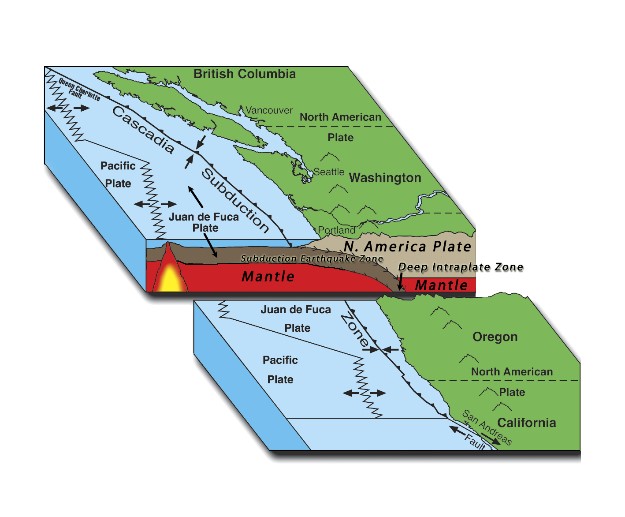
The Cascadia Subduction Zone is a 700-mile fault that runs from northern California up to British Columbia and is about 70-100 miles off the Pacific coast shoreline. There have been 43 earthquakes in the last 10,000 years within this fault. The last earthquake that occurred in this fault was on Jan. 26, 1700, with an estimated 9.0 magnitude. This earthquake caused the coastline to drop several feet and a tsunami to form and crash into the land. Evidence for this great earthquake came from Japan. Japanese historical records indicate that a destructive distantly-produced tsunami struck their coast on Jan. 26, 1700. By studying the geological records and the flow of the Pacific Ocean, scientists have been able to link the tsunami in Japan with the great earthquake from the Pacific Northwest. Native American legends also support the timing of this last event.
Oregon has the potential for a 9.0+ magnitude earthquake caused by the Cascadia Subduction Zone and a resulting tsunami of up to 100 feet in height that will impact the coastal area. There is an estimated five to seven minutes of shaking or rolling that will be felt along the coastline with the strength and intensity decreasing the further inland you are.
The Cascadia Subduction Zone has not produced an earthquake since 1700 and is building up pressure where the Juan de Fuca Plate is subsiding underneath the North American plate. Currently, scientists are predicting that there is about a 37% chance that a megathrust earthquake of 7.1+ magnitude in this fault zone will occur in the next 50 years. This event will be felt throughout the Pacific Northwest.
With the current preparedness levels of Oregon, we can anticipate being without services and assistance for at least two weeks, if not longer, when the Cascadia Subduction Zone earthquake occurs. While this will be difficult to overcome, individuals, businesses, schools, government and communities can take steps to prepare. Take action now by actively planning and preparing yourself and your community to "Be 2 Weeks Ready" for disasters.
Cascadia Island Mapping
In the event of a Cascadia Subduction Zone earthquake and/or tsunami, coastal populations will become isolated into “islands” due to landslides, liquefaction, and damaged infrastructure like bridges.The Oregon Department of Emergency Management’s “Cascadia Island Mapping Pilot Project” maps coastal populations in relation to areas where infrastructure damage is likely to occur during an earthquake and/or tsunami
In the summer of 2016, OEM organized workshops with coastal communities. Participants included city and county officials, public works departments and others who could provide insight on road damage and the residents, workers, and visitors within the plotted 'islands.'
Download the findings and data gathered from this project.
For general inquiries about the project, contact Althea Rizzo at althea.rizzo@oem.oregon.gov.
For GIS data, contact Daniel Stoelb at daniel.stoelb@oem.oregon.gov.